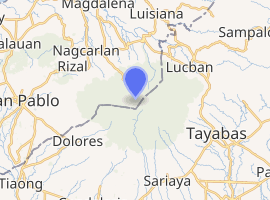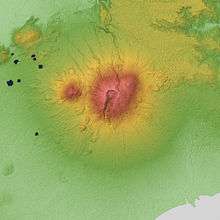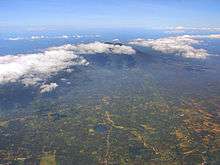Mount Banahaw
Mount Banahaw (IPA: [bɐnɐhaw]; also spelled as Banahao and Banájao) is a potentially active volcano on Luzon in the Philippines. The three-peaked volcano complex is located between the provinces of Laguna and Quezon and is the tallest mountain in the Calabarzon region dominating the landscape for miles around.[4]
| Mount Banahaw | |
|---|---|
| Banahao | |
| Highest point | |
| Elevation | 2,170 m (7,120 ft) [1][2] |
| Prominence | 1,919 m (6,296 ft) [1] |
| Listing | |
| Coordinates | 14°04′03″N 121°29′33″E [1][3] |
| Geography | |
.svg.png) Mount Banahaw .svg.png) Mount Banahaw | |
| Country | Philippines |
| Region | Calabarzon |
| Province | |
| Cities and municipalities | |
| Topo map | Mount Banahaw Relief Map, SRTM-1.jpg |
| Geology | |
| Mountain type | Complex volcano |
| Volcanic arc/belt | Macolod Corridor |
| Last eruption | 1909 |
| Climbing | |

| |
The mountain is considered by many as a holy mountain, thus a bundok dambana, and is popular among pilgrims along with mountain climbers. It is located in a protected area known as Mounts Banahaw–San Cristobal Protected Landscape covering 10,901 hectares (26,940 acres) of land.[5][6]
Physical characteristics
The andesitic Banahaw volcano complex is composed of several mountains with Mount Banahaw, the largest with a maximum elevation of 2,170 metres (7,119 ft) above mean sea level. The summit is topped by a 1.5 by 3.5 kilometres (0.93 mi × 2.17 mi) and 210 metres (690 ft) deep crater that is breached on the southern rim believed to have been caused by the 1730 eruption. Prior to 1730, a lake occupied the summit crater of Mount Banahaw. The resulting flood destroyed the town of Sariaya, Quezon located below the mountain.[7]

- Other peaks:
- Mount San Cristobal (on the western slope)
- Mount Banahaw de Lucban (at northeastern slope)
- Buho Masalakot Domes (at southwestern slope)
- Mount Mayabobo
- Maars: Lake Dagatan and Lake Ticab
- Thermal Areas:
- Tiaong-San Pablo hot/warm springs
- Bakia warm/cold springs
- Sampaloc warm springs
- Mainit hot/warm springs
- Cagsiay hot/warm springs
Importance to locals
Banahaw is a traditional pilgrimage site for locals, believed by many as a holy mountain, a spiritually-charged location. The mountain and its environs are considered sacred by local residents; the water from its sacred springs are deemed "holy water" for allegedly having beneficial qualities, issuing forth from locations called "puestos" or "holy sites". These sites are unique natural features composed not only of springs, but also caves, streams and boulders; with names with biblical allusions, and shrines erected in, on or around them. These locations were allegedly revealed to a man named Agripino Lontoc by the "Santong Boses" or the "Holy Voices", which also gave the names to these places way back during the Spanish colonial sra. Another one of these mountains is the adjacent Mount Banahaw de Lucbán.[7]
Banahaw is also a part of the Makiling-Banahaw Watershed, a reservation of the National Power Corporation (NAPOCOR) providing steam for power generation, as well as water source for domestic and industrial uses.[8]
Hiking activity on Banahaw

The mountain is popular not only to pilgrims but also among mountain climbers being the closest over 2,000-metre (6,600 ft) mountain from Manila. Before 2004, hiking activity peaks during Holy Week each year, with climbers numbering to the thousands. At least four trails exist from Dolores, Sariaya, and other towns of Quezon located on its foothills. The most frequently used trails are the Cristalino and Tatlong Tangke, taking an average of 9 and 5 hours, respectively. These two trails originate from Barangay Kinabuhayan in Dolores, and meet near the summit, which is actually the rim of the Banahaw caldera. On the summit are viewpoints, labeled as Durungawan I, II, and III, which are the usual destination for pilgrims and hikers. Other points of interest include the "Kuweba ng Diyos Ama" (Tagalog: Cave of God the Father) and the spring at Brgy. Kinabuhayan, said to have curative powers.[7]
Pollution
Due to incessant climbing activity the mountain trails have become littered with trash. In March 2004, the Department of Environment and Natural Resources ordered a 5-year suspension of hiking activity in the mountains, covering the Dolores and Sariaya trails. Reopening was delayed was then scheduled to March 2012, but was further extended to February 2015.[4][9][10] However, the mountain remains closed to hikers until today.
Endemic fauna
Frogs endemic to Mount Banahaw include Platymantis banahao, Platymantis indeprensus, Platymantis montanus, Platymantis naomii, and Platymantis pseudodorsalis.
See also
References
- "Philippines Mountains" – Ultra Prominence Page. Peaklist.org. Listed here as "Mount Banahao". Retrieved April 5, 2012.
- "Mount Banahao, Philippines" Peakbagger.com. Retrieved April 5, 2012.
- "Banahaw". Global Volcanism Program. Smithsonian Institution.
- "Mount Banahaw". PinoyMountaineer. January 7, 2009. Archived from the original on April 13, 2009. Retrieved March 20, 2009.
- "Protected Areas in Region IV-A (CALABARZON)" Archived September 29, 2011, at the Wayback Machine. Protected Areas and Wildlife Bureau. Retrieved on September 26, 2011.
- "NIPAS Initial Components (PDF)" Archived March 20, 2012, at the Wayback Machine. Protected Areas and Wildlife Bureau. Retrieved on September 26, 2011.
- "Mount Banahaw". Malapascua. Retrieved on September 25, 2011.
- "Makiling-Banahaw Watershed". www.napocor.gov.ph. Retrieved February 27, 2020.
- "Mountain News: Mt. Halcon and Mt. Banahaw status updated". Pinoy Mountaineer. Retrieved on September 27, 2011.
- "Banahaw, San Cristobal mountains closed to trekkers till 2015". Inquirer News. Retrieved on February 26, 2012.
External links
| Wikimedia Commons has media related to Mount Banahaw. |
- Philippine Institute of Volcanology and Seismology, Mt Banahaw page
- "Mount Banahao, Philippines" on Peakbagger